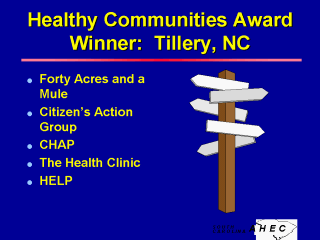 |
Tillery,
NC is a small rural community in the northeastern part of the state. It consists primarily
of African American families who remained after FDR’s “Forty Acres and a Mule”
project failed in the 1940’s. Today’s citizens own and work their own lands, and over
the decades led a long string of local self-improvement efforts, finally forming the
“Concerned Citizens of Tillery” (CCT) in 1978 to protest the school board’s decision
to close the town’s school. While unsuccessful at retaining their school, they opened a
community center and organized groups for children and the elderly. With help from two
Catholic nuns, they organized an “envisioning workshop” and identified health care as
the community’s most pressing need. In 1984 they invited members of the NC Student Rural
Health Coalition to hold a two week Summer Health Fair. In 1987 they sponsored monthly
health screening clinics with the medical student chapters of Duke and East Carolina
Universities. By 1990 they had formed CHAP (Community Health Advocacy Program) in which
medical students taught grass-roots “health advocates” about heart disease, high blood
pressure, diabetes, disease prevention and health promotion. In 1991 they refurbished the
old “Curin’ House” and opened a health clinic consisting of 3 exam rooms, a
reception room, and a laboratory, staffed by medical students. In 1992 they formed HELP
(Halifax Environmental Loss Prevention) to address problems with disposal of offal, blood,
and other debris from the massive chicken and hog processing plants in the county. These
and many other successful projects earned them the national Healthier Communities Award in
1993. |
